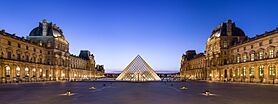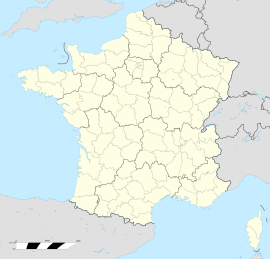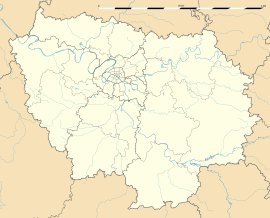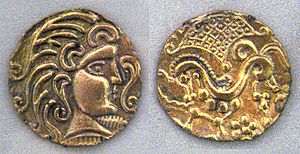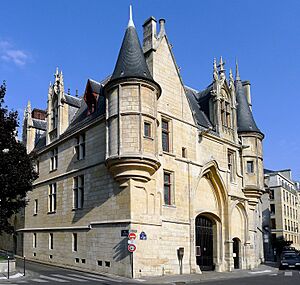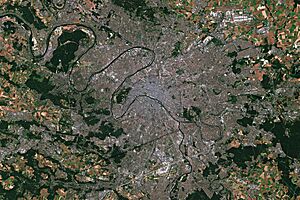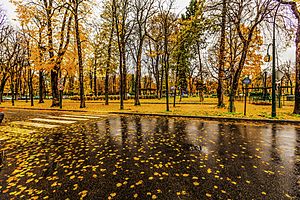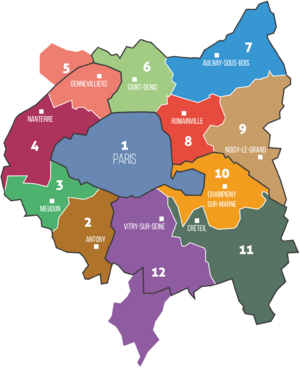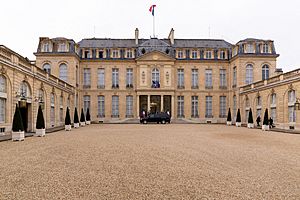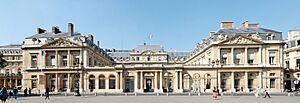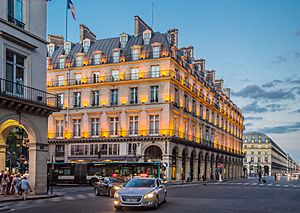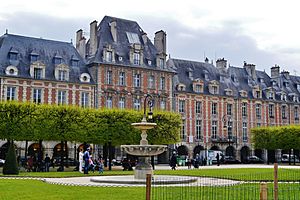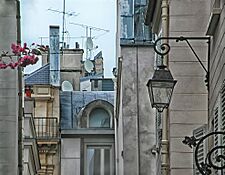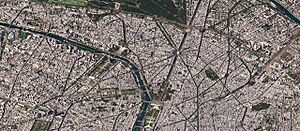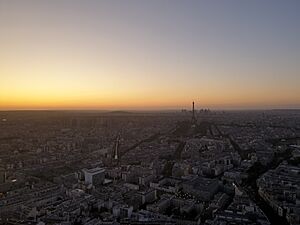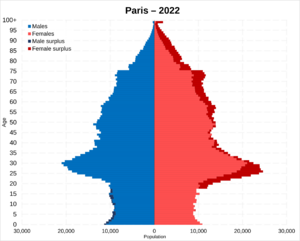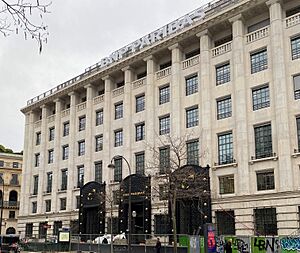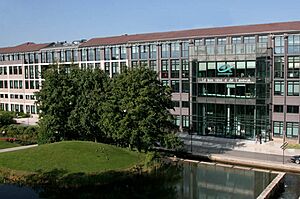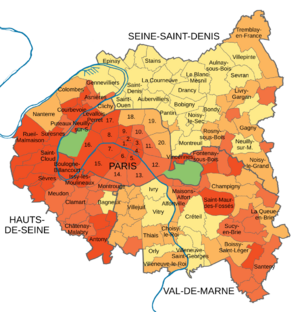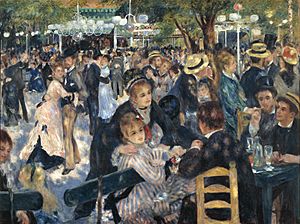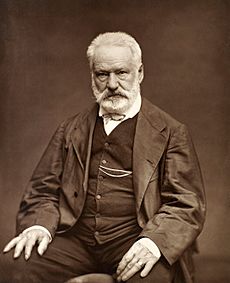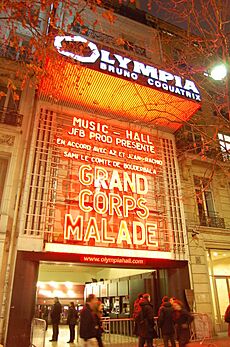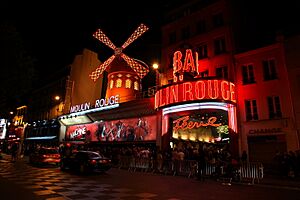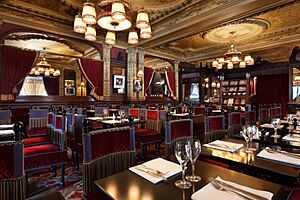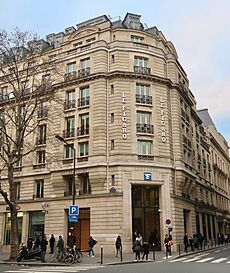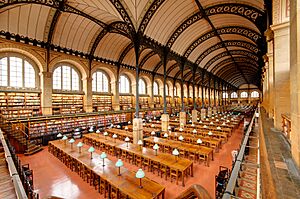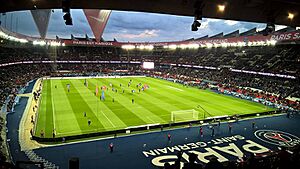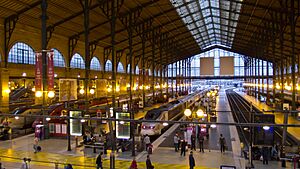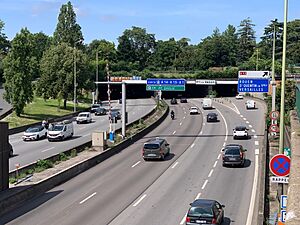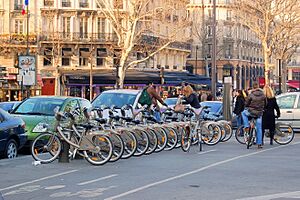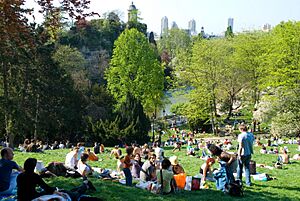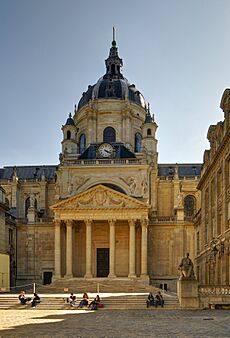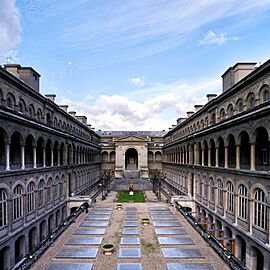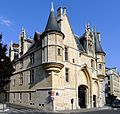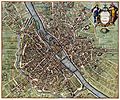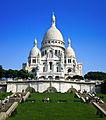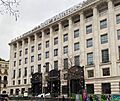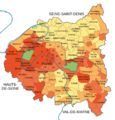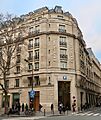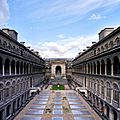Paris facts for kids
Quick facts for kids
Paris
|
|||
|---|---|---|---|
|
|
|||
|
|||
| Motto(s):
Fluctuat nec mergitur
"Tossed by the waves but never sunk" |
|||
| Country | France | ||
| Region | Île-de-France | ||
| Department | Paris | ||
| Arrondissement | None | ||
| Intercommunality | Métropole du Grand Paris | ||
| Subdivisions | 20 arrondissements | ||
| Area
1
|
105.4 km2 (40.7 sq mi) | ||
| • Urban
(2021)
|
2,824.2 km2 (1,090.4 sq mi) | ||
| • Metro
(2021)
|
18,940.7 km2 (7,313.0 sq mi) | ||
| Population
(Jan 2025)
|
2,048,472 | ||
| • Rank | 9th in Europe 1st in France |
||
| • Density | 19,435/km2 (50,337/sq mi) | ||
| • Urban
(2021)
|
10,890,751 | ||
| • Urban density | 3,856.23/km2 (9,987.58/sq mi) | ||
| • Metro
(2021)
|
13,171,056 | ||
| • Metro density | 695.3838/km2 (1,801.036/sq mi) | ||
| Demonym(s) | Parisian(s) (en) Parisien(s) (masc.), Parisienne(s) (fem.) (fr), Parigot(s) (masc.), "Parigote(s)" (fem.) (fr, colloquial) | ||
| Time zone | UTC+01:00 (CET) | ||
| • Summer (DST) | UTC+02:00 (CEST) | ||
| INSEE/Postal code |
75056 /75001–75020, 75116
|
||
| Elevation | 28–131 m (92–430 ft) (avg. 78 m or 256 ft) |
||
| 1 French Land Register data, which excludes lakes, ponds, glaciers > 1 km2 (0.386 sq mi or 247 acres) and river estuaries. | |||
Paris (French pronunciation: [paʁi]) is the capital and largest city of France. In January 2025, about 2 million people lived in Paris. The city covers an area of over 105 square kilometers. Paris is the fourth most populated city in the European Union. It has been a major global center for finance, diplomacy, commerce, culture, fashion, and gastronomy since the 1600s. Paris is also known as the "City of Light" because of its important role in the arts and sciences, and its early use of street lighting.
The City of Paris is the heart of the Île-de-France region. This region had an estimated population of over 12 million people in January 2023. This is about 19% of France's total population. The Paris Region also had the highest economic output in the European Union in 2021. In 2022, Paris was ranked as the ninth most expensive city in the world to live in.
Paris is a major hub for trains, roads, and air travel. It has two international airports: Charles de Gaulle Airport and Orly Airport. Paris has one of the most eco-friendly transport systems. It is one of only two cities to win the Sustainable Transport Award twice. Paris is famous for its museums and buildings. The Louvre museum had 8.9 million visitors in 2023. It is the most visited art museum in the world. Other famous museums include the Musée d'Orsay and the Pompidou Centre. The historic area along the Seine river has been a UNESCO World Heritage Site since 1991.
Paris is home to many international groups like UNESCO and the OECD. Famous sports clubs like Paris Saint-Germain (football) and Stade Français (rugby) are based here. The Stade de France, a large stadium, is just north of Paris. Paris hosts the French Open tennis tournament every year. The city also hosted the Olympic Games in 1900, 1924, and 2024. Major football and rugby World Cups have also been held in Paris. The Tour de France bicycle race ends on the Avenue des Champs-Élysées each July.
Contents
What's in a Name?
The ancient town that became Paris was first mentioned around 50 BC. Julius Caesar called it Luteciam Parisiorum. This means 'Lutetia of the Parisii'. Later, it was called Paris in 1265. During Roman times, it was known as Lutetia or Lutecia. This name might come from a Celtic word meaning 'mouse' or 'marsh'.
The name Paris comes from its early people, the Parisii. They were a Gallic tribe from the Iron Age. The meaning of their name is still debated. Some think it means 'cauldron' or 'the makers'. Others suggest it means 'spear people'. The city's name is not linked to Paris from Greek myths.
People who live in Paris are called Parisians in English. In French, they are Parisiens (male) or Parisiennes (female).
A Journey Through Time: Paris History
How Paris Began
The Parisii people lived in the Paris area from about 250 BC. A main trade route crossed the Seine river at the Île de la Cité. This island slowly became an important trading spot. The Parisii traded with many river towns and made their own coins.
Julius Caesar took over the Paris area for the Roman Republic in 52 BC. The Romans then built a settlement on Paris's Left Bank. This Roman town was first called Lutetia. It grew into a rich city with a forum, baths, temples, and theaters.
By the end of the Western Roman Empire, the town was called Parisius. This Latin name later became Paris in French. Christianity arrived in the mid-200s AD. Saint Denis, the first Bishop of Paris, brought it. Legend says he was beheaded on a hill called Mons Martyrum (Hill of Martyrs), now Montmartre. He then walked headless to the north of the city. Where he fell became a religious site, the Basilica of Saint-Denis. Many French kings are buried there.
Clovis the Frank, the first king of the Merovingian dynasty, made Paris his capital in 508. As the Franks took control, many moved to Paris. This led to the Parisian Francien dialects. Vikings attacked Paris in 845, but the city's bridges helped defend it in the Siege of Paris (885–886). Because of this, Odo of France, the Count of Paris, was chosen as king of West Francia. From the Capetian kings, starting with Hugh Capet in 987, Paris slowly became the biggest and richest city in France.
From Middle Ages to Louis XIV
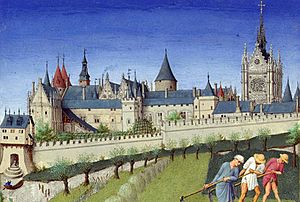
By the late 1100s, Paris was France's main city for politics, money, religion, and culture. The royal home, the Palais de la Cité, was on the Île de la Cité. In 1163, Bishop Maurice de Sully began building the Notre Dame Cathedral.
Later, Paris's cultural center moved to the Right Bank. In 1137, a new market, now Les Halles, opened. The city's river trade group, which became Paris's first city government, was also there.
In the late 1100s, Philip Augustus built up the Louvre fortress to protect the city. He also built the first city walls between 1190 and 1215. He rebuilt bridges and paved main roads. In 1190, he turned Paris's old cathedral school into the University of Paris. Students from all over Europe came to study there.
By 1328, Paris had 200,000 people, making it Europe's most populated city. During the Hundred Years' War, the English took over Paris in 1420. Even with Joan of Arc's efforts in 1429, the English stayed until 1436.
In the late 1500s, Paris was a stronghold for the Catholic League. They organized the St. Bartholomew's Day massacre in 1572, where many French Protestants were killed. The fighting ended when Henry IV became king in 1594. He improved the city by building the Pont Neuf bridge and the Place des Vosges square.
In the 1600s, Cardinal Richelieu wanted to make Paris the most beautiful city in Europe. He built new bridges, a chapel, and a palace. Later, Louis XIV moved his court to Versailles in 1682. Even so, arts and sciences in Paris still thrived. The king had the city walls removed and replaced them with tree-lined boulevards.
Paris in the 18th and 19th Centuries
Paris grew from 400,000 people in 1640 to 650,000 in 1780. The Champs-Élysées boulevard was extended west. Working-class areas in the east became very crowded.
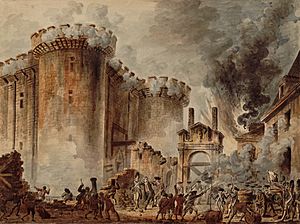
Paris was a center for new ideas in philosophy and science, known as the Age of Enlightenment. In 1751, Diderot and D'Alembert published their Encyclopédie. The first manned hot air balloon flight happened in Paris in 1783. Paris was also a major center for finance, book publishing, and fashion.
In the summer of 1789, Paris became the heart of the French Revolution. On July 14, a crowd took over the Bastille prison. This was a major symbol of royal power. The first independent city council, the Paris Commune, met and elected a mayor.
Louis XVI and the royal family were brought to Paris. In 1793, the king, queen, and mayor were executed. Many others were also executed during the Reign of Terror. Revolutionary groups ruled Paris until Napoleon Bonaparte took power in 1799.
Paris's population dropped during the Revolution but grew to 660,000 by 1815. Napoleon built monuments like the Arc de Triomphe. He also improved the city's water system and built the first metal bridge, the Pont des Arts.

After Napoleon, a new king, Louis Philippe I, came to power in 1830. The first railway line to Paris opened in 1837. This led to many people moving from other parts of France to the city. In 1848, Louis-Philippe was overthrown. His successor, Napoleon III, and Georges-Eugène Haussmann, started a huge project. They built wide new boulevards, a new opera house, and parks like the Bois de Boulogne. In 1860, Paris expanded to its current size.
During the Franco-Prussian War (1870–1871), the Prussian Army surrounded Paris. The city surrendered in January 1871. A revolutionary government, the Paris Commune, then took power for two months. It was later put down by the French army.
In the late 1800s, Paris hosted two big international events. The 1889 Universal Exposition featured the new Eiffel Tower. The 1900 Universal Exposition gave Paris the Pont Alexandre III and the first Paris Métro line. Paris also became a center for new art movements like Impressionism.
Paris in the 20th and 21st Centuries
By 1901, Paris had about 2.7 million people. Many artists from around the world, like Pablo Picasso and Henri Matisse, moved to Paris. New art styles like Cubism started here.
During World War I, Paris was sometimes on the front line. Taxis helped transport soldiers to the front. The city was also bombed. After the war, Paris remained a magnet for writers, musicians, and artists. Famous people like Ernest Hemingway and Josephine Baker lived there.
Many students and activists from French colonies also came to Paris. They later became leaders in their home countries.

On June 14, 1940, the German army marched into Paris. The city was declared an "open city". In July 1942, French police arrested thousands of Jews, including children. They were sent to concentration camps. On August 25, 1944, the city was freed by French and American forces. General Charles de Gaulle led a large crowd down the Champs Élysées.
In the 1950s and 1960s, Paris saw protests related to the Algerian War. In May 1968, students protested and built barricades. Many workers joined them, leading to a general strike. The May 1968 events in France led to the University of Paris splitting into 13 separate campuses. In 1977, Jacques Chirac became the first elected mayor of Paris since 1793. The Tour Montparnasse, a tall building, was built between 1969 and 1973. It is still the only building over 32 stories in the city center.
Paris's population dropped from 1954 to 1990 as families moved to the suburbs. A suburban train network, the RER, was built. The Périphérique expressway, which circles the city, was finished in 1973.
Many French presidents wanted to leave their mark on Paris. President Georges Pompidou started the Centre Georges Pompidou (1977). François Mitterrand built the Opéra Bastille (1985–1989) and the Louvre Pyramid (1983–1989).
In the early 2000s, Paris's population started to grow again. In 2001, Bertrand Delanoë became the first socialist mayor. He introduced Vélib', a bike rental system, in 2007. He also turned a highway along the Seine into a park.
In 2007, President Nicolas Sarkozy started the Grand Paris project. This project aims to connect Paris more closely with its surrounding towns. The new area, called the Metropolis of Grand Paris, was created on January 1, 2016. It has a population of 6.7 million. Plans for the Grand Paris Express, a new metro system, were approved in 2011. It is expected to be finished by 2030.
In January 2015, there were attacks across the Paris region. Many people marched in Paris to show unity against terrorism. In November 2015, other terrorist attacks killed 130 people.
On April 22, 2016, the Paris Agreement was signed by 196 nations. This agreement aims to limit the effects of climate change.
On April 15, 2019, the historic Notre Dame Cathedral caught fire. The fire destroyed the spire and most of the roof. Firefighters saved the main structure. The cathedral reopened on December 7, 2024, after over 2,000 days of work.
As of 2024, Paris is considered one of the world's most important cities for global connections.
Paris Geography
Where is Paris Located?
Paris is in northern central France. It sits in a bend of the Seine river. The river has two islands, the Île Saint-Louis and the larger Île de la Cité. These islands form the oldest part of Paris. The Seine flows about 375 kilometers downstream from Paris to the English Channel. Paris is mostly flat, with its lowest point at 35 meters above sea level. The highest hill is Montmartre at 130 meters.
Paris, not including the Bois de Boulogne and Bois de Vincennes parks, is about 87 square kilometers. It is surrounded by the 35-kilometer Boulevard Périphérique ring road. Paris got its current shape in 1860 when it added nearby towns. This created the 20 clockwise-spiraling arrondissements (city districts). In 1929, the Bois de Boulogne and Bois de Vincennes parks were added, making the city's area about 105 square kilometers. The larger metropolitan area is 2,300 square kilometers.
From the "point zero" in front of Notre-Dame cathedral, Paris is about 450 kilometers southeast of London.
Paris Weather
Paris has an oceanic climate, typical of western Europe. This means it has cool winters with frequent rain and cloudy skies. Summers are mild to warm. Very hot or very cold weather is rare.
Summer days are usually pleasant, with average temperatures between 15 and 25 degrees Celsius. There are a few days each year when temperatures go above 32 degrees Celsius. Sometimes, there are longer heat waves, like in 2003, when temperatures reached 40 degrees Celsius.
Spring and autumn have mild days and cool nights. The weather can change quickly in these seasons. In winter, there is not much sunshine. Days are cool, and nights are cold but usually above freezing. Light frosts are common, but temperatures rarely drop below -5 degrees Celsius. Paris sometimes gets light snow.
Paris gets about 641 millimeters of rain each year. Rainfall is spread evenly throughout the year. Paris is known for sudden, heavy rain showers. The highest temperature ever recorded was 42.6 degrees Celsius on July 25, 2019. The lowest was -23.9 degrees Celsius on December 10, 1879.
How Paris is Governed
City Government
For most of its history, Paris was directly ruled by the king or president of France. In 1974, Paris was given the power to govern itself. The first modern elected mayor was Jacques Chirac in March 1977. The current mayor is Anne Hidalgo, who was first elected in April 2014 and re-elected in June 2020.
Paris voters do not directly elect the mayor. Instead, voters in each of the city's 20 arrondissements (districts) elect members to the Conseil de Paris (Council of Paris). This council then elects the mayor. The council has 163 members. Each arrondissement gets a number of seats based on its population.
Before the 2020 election, each arrondissement had its own town hall and elected council. Now, the first four arrondissements are combined into one area called Paris Centre. The other 16 arrondissements still have their own mayors.
Greater Paris Metropolis
In January 2016, the Métropole du Grand Paris was created. This is a group that helps Paris and its closest suburbs work together. It includes Paris and towns from three nearby departments. It also includes seven towns from further out, like those with Paris's main airports. The Metropole covers 814 square kilometers and had 6.9 million people in 2015.
A Metropolitan Council of 210 members runs this new group. These members are chosen by the councils of the towns in the Metropole. Their main jobs include city planning, housing, and protecting the environment.
Regional Government
The Île de France region, which includes Paris and its surrounding areas, is governed by the Regional Council. This council has 209 members from different towns. In December 2015, a group of center and right-wing parties won the regional election. They defeated the Socialists, who had run the region for 17 years.
National Government
As the capital of France, Paris is where the French government is located. The President lives at the Élysée Palace. The Prime Minister's office is at the Hôtel Matignon. Government offices are found in different parts of the city.
Both parts of the French Parliament are on the Left Bank. The Senate meets in the Palais du Luxembourg. The National Assembly, which is more important, meets in the Palais Bourbon.
France's highest courts are in Paris. The Court of Cassation, which reviews criminal and civil cases, is in the Palais de Justice. The Conseil d'État, which advises the government and handles cases against public bodies, is in the Palais-Royal.
Paris also hosts the main offices of several international groups. These include UNESCO, the Organisation for Economic Co-operation and Development (OECD), and the European Space Agency.
Police Force
The Prefecture of Police of Paris is mainly in charge of safety in Paris. It oversees the National Police units that patrol the city and nearby areas. It also provides emergency services, like the Paris Fire Brigade. Its main office is on the Île de la Cité.
There are 43,800 officers and over 6,000 vehicles. The police have a special unit for crowd control called the Compagnies Républicaines de Sécurité (CRS). The National Gendarmerie, part of the French Armed Forces, also helps the police.
Crime in Paris is similar to other large cities. Serious violent crime is rare in the city center. Large protests can happen, but they are usually managed by the police.
Paris Cityscape
City Design and Buildings
Paris is one of the few major cities that has not been destroyed by disasters or wars. This means its long history can be seen in its streets and buildings. Centuries of rulers have added their own architectural styles. This has created a city rich in history and beauty. Originally, Paris was made of islands and sandbanks in the Seine river. Today, two islands remain: Île Saint-Louis and the Île de la Cité.
Modern Paris's city plan and building style are largely thanks to Napoleon III and Baron Haussmann. From 1853 to 1870, they rebuilt the city center. They created wide boulevards and squares. They also made sure buildings along these boulevards had a similar look. They built the main parks around central Paris.
Paris has had strict building rules since the 1600s. These rules control how buildings line up with streets and how tall they can be. The Tour Montparnasse, at 210 meters, was Paris's tallest building until 2011. Now, the Tour First in La Défense is taller.
Housing in Paris

In 2018, the most expensive street in Paris for homes was Avenue Montaigne. Homes there cost about 22,372 euros per square meter. In 2011, Paris had about 1.3 million homes. Most of these (85.9%) were main homes.
Sixty-two percent of buildings in Paris were built before 1949. Only 18 percent were built after 1974. Two-thirds of the city's homes are studio or two-room apartments. On average, there are 1.9 people per home in Paris. Only 33 percent of Parisians own their homes; most rent. In 2017, social housing made up 19.9 percent of homes in Paris. This varies a lot by district. For example, it's 2.6 percent in the wealthy 7th arrondissement and 39.9 percent in the 19th arrondissement.
In February 2019, a count of homeless people in Paris found 3,641 individuals. Most were living on the streets or in parks. This was an increase from 2018.
Paris Suburbs
Paris's city limits have not changed much since 1860, except for adding the Bois de Boulogne and Bois de Vincennes parks. The "District de la région parisienne" was reorganized in 1968. Paris became its own department. Its suburbs were divided into three new departments. This district was renamed "Île-de-France" in 1977.
The lack of good transport between Paris and its suburbs became a problem as the area grew. In 1961, Paul Delouvrier worked to fix this. He planned five new suburban "new cities" and the RER train network.
Many other suburban housing areas were built in the 1960s and 1970s. These offered low-cost homes for a growing population. Over time, these areas became home to people with fewer resources.
These areas, called quartiers sensibles (sensitive quarters), are mostly in northern and eastern Paris. They are found around areas like Goutte d'Or and Belleville.
The way people live in the Paris area is similar to 19th-century Paris. Wealthy people live in the west and southwest. Middle and working-class people live in the north and east.
Paris Population
In January 2023, the population of Paris was 2,102,650. This was a decrease from 2,165,423 in January 2022. Between 2013 and 2023, the population dropped by about five percent. The Mayor of Paris, Anne Hidalgo, said this shows the city is becoming less crowded. Even with the drop, Paris is still the most densely populated city in Europe. This decline is partly due to a lower birth rate and people moving to the suburbs.
Paris is the fourth largest city in the European Union. It is smaller than Berlin, Madrid, and Rome. The current population of Paris is lower than its peak of 2.9 million in 1921. This is because families are smaller now, and many people moved to the suburbs from 1962 to 1975. High rents and offices replacing homes also played a role. The population started to increase again in the early 2000s, reaching 2.25 million in 2011, before a slight decline.
Paris is the center of a large urban area. This area, called the agglomération Parisienne, had a population of 10,785,092 in 2017. This makes it the largest urban area in the European Union. The wider "functional area" of Paris had 13,024,518 people in 2017. This is 19.6% of France's population and the largest metropolitan area in the Eurozone.
In 2012, Paris was the most densely populated city in the European Union. There were 21,616 people per square kilometer within the city limits.
People from Other Countries
Under French law, people born in other countries who were not French citizens at birth are called immigrants. In 2012, many Paris residents were immigrants from Europe, North Africa, and other parts of Africa and Asia.
In the wider Paris Region, there were many immigrants from Europe, North Africa (Maghreb), and sub-Saharan Africa. There were also people from Turkey, other parts of Asia, and the Americas.
In 2012, about 8,810 British citizens and 10,019 United States citizens lived in the City of Paris. In the entire Paris Region, there were 20,466 British citizens and 16,408 United States citizens.
In 2020–2021, about 6 million people in the Paris Region were either immigrants or had at least one immigrant parent. This is about 41% of the population.
Religion in Paris
At the start of the 1900s, Paris was the largest Catholic city in the world. French census data does not include information about religion. However, a 2011 survey found that 61 percent of people in the Paris Region identified as Roman Catholic. The same survey showed 7 percent were Muslims, 4 percent Protestants, and 2 percent Jewish. About 25 percent said they had no religion.
In 2012 and 2013, it was estimated that there were almost 500,000 Muslims in Paris. The Jewish population in the Paris Region was estimated to be 282,000 in 2014. This is one of the largest Jewish populations outside of Israel and the United States.
Paris Economy
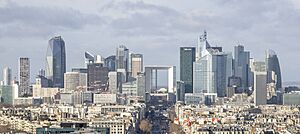
Paris's economy is mostly based on services and trade. Out of 390,480 businesses in Paris, over 80% are in commerce, transport, and various services. Only 3.8% are in industry. The situation is similar in the wider Paris Region.
In 2012, most jobs in the Paris Region were in market services (59.5%). This includes trade, professional services, and finance. About 26.9% of jobs were in non-market services like healthcare and public administration.
The Paris Region had 5.4 million paid employees in 2010. About 2.2 million of these worked in 39 business districts. The largest district, the QCA (central business district), had 500,000 employees. The main jobs there were in finance and business services.
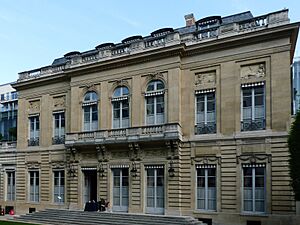
The second largest business district is La Défense, west of Paris. In 2010, it had 144,600 employees. Many worked in finance and business support. Other important districts include Neuilly-sur-Seine and Levallois-Perret.
In 2021, all the top French companies listed in the Fortune Global 500 had their main offices in the Paris Region. The Paris Region is France's leading economic area. In 2021, its economic output was the highest among EU metropolitan regions.
The Paris Region's economy has moved from industry to high-value services like finance and IT. It also has high-tech manufacturing. While services dominate, the region is still important for making things like airplanes and cars.
In 2018, Paris was one of the most expensive cities in the world, along with Singapore and Hong Kong. Station F is the world's largest startup incubator.
Jobs and Income
In 2007, most of Paris's paid employees worked in business services. These jobs were mainly in the northwestern 8th, 16th, and 17th arrondissements. Financial companies are in the central-western 8th and 9th arrondissements. Department stores employ many workers, mostly women. Many Parisians also work in hotels, restaurants, and other services.
About 19% of Paris employees work for the government in administration or education. Healthcare and social workers are mostly in hospitals and social housing in the outer 13th, 14th, 18th, 19th, and 20th arrondissements.
Manufacturing in Paris is mostly in its suburbs. About 75,000 manufacturing workers are in Paris, mainly in textiles and clothing. In 2015, the Paris region's aerospace companies employed 100,000 people. Car companies employed another 100,000.
Incomes are higher in western Paris and its western suburbs. They are lower in the northern and eastern parts of the city. In 2012, 14% of Paris households earned less than €977 per month, which is the official poverty line. In the 19th arrondissement, 25% of residents lived below the poverty line. In the wealthiest 7th arrondissement, only 7% did. The unemployment rate in Paris was 6% in late 2021, the lowest in 13 years.
Tourism in Paris
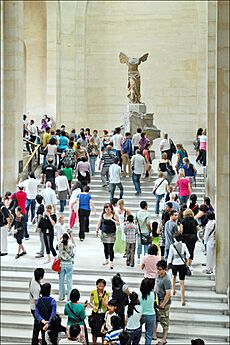
As of 2024, Paris has been named the world's most attractive city for four years in a row. However, it was 9th in terms of international tourist arrivals.
Tourism in the Paris region continued to grow in 2022. It reached 44 million visitors, a 95% increase from 2021. This was still 13% lower than in 2019.
In 2019, the Greater Paris area had a record 38 million visitors. This included 12.2 million French visitors. The most foreign visitors came from the United States (2.6 million).
In 2018, Paris was the second busiest airline destination in the world, with 19.10 million visitors. In 2016, about 12.4% of workers in Greater Paris worked in tourism-related jobs.
Paris's top cultural attractions in 2022 were the Louvre Museum (7.7 million visitors) and the Eiffel Tower (5.8 million visitors). Other popular spots included the Musée d'Orsay and the Centre Pompidou.
In 2019, Greater Paris had over 2,000 hotels with more than 121,000 rooms. It also had 60,000 homes listed on Airbnb.
Paris Culture
Art and Sculpture
For centuries, Paris has drawn artists from all over the world. This has given Paris a reputation as the "City of Art." Italian artists greatly influenced art in Paris in the 1500s and 1600s. French kings hired Parisian artists to decorate their palaces. Famous sculptors like Girardon and Coysevox worked for the royal court. In 1648, the Royal Academy of Painting and Sculpture was founded. It was France's top art school until 1793.
Paris was at its artistic peak in the 1800s and early 1900s. Many artists lived and studied there. These included Henri de Toulouse-Lautrec, Édouard Manet, and Claude Monet. Paris was key to the development of Romanticism and Impressionism. Movements like Art Nouveau and Cubism also started in Paris. Many artists from other countries came to Paris to show their work. Artists like Pablo Picasso, Henri Matisse, and Vincent van Gogh became linked with Paris.
Famous sculptors who made their name in Paris include Frédéric Auguste Bartholdi (who designed the Statue of Liberty) and Auguste Rodin. The "Golden Age" of the School of Paris ended between the two world wars.
Paris Museums
The Louvre museum had 2.8 million visitors in 2021. It remains the most visited museum in the world. Its famous treasures include the Mona Lisa and the Venus de Milo statue. The second most visited museum in 2021 was the Centre Georges Pompidou, also known as Beaubourg. It houses the Musée National d'Art Moderne.
The third most visited museum in 2021 was the National Museum of Natural History. It is known for its dinosaur artifacts and mineral collections. It was followed by the Musée d'Orsay, which features 19th-century art and French Impressionists. Paris also has one of Europe's largest science museums, the Cité des sciences et de l'industrie.
Other popular Paris museums in 2021 included the Fondation Louis Vuitton and the Musée du Quai Branly – Jacques Chirac. The latter features art from Africa, Asia, Oceania, and the Americas. The Musée Carnavalet tells the history of Paris.
There are also museums dedicated to individual artists, like the Musée Picasso and the Musée Rodin. The military history of France is shown at the Musée de l'Armée at Les Invalides. Besides national museums, the City of Paris runs 14 museums. These include the Carnavalet Museum and the Catacombs of Paris. There are also important private museums. The Contemporary Art museum of the Louis Vuitton Foundation opened in October 2014.
Theatre in Paris
Paris's largest opera houses are the 19th-century Opéra Garnier and the modern Opéra Bastille. The Opéra Garnier usually shows classic ballets and operas. The Opéra Bastille has a mix of classic and modern shows. The Philharmonie de Paris, a modern concert hall, opened in January 2015. Another musical landmark is the Théâtre des Champs-Élysées.
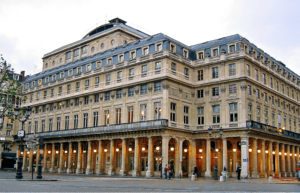
Theatre has always been important in Parisian culture. The oldest and most famous Paris theatre is the Comédie-Française, founded in 1680. It is run by the French government and performs mostly French classic plays. Other famous theatres include the Odéon-Théâtre de l'Europe and the Théâtre Mogador.
Music halls and cabarets are famous Paris traditions. The Moulin Rouge opened in 1889. It became the birthplace of the French Cancan dance. It helped make singers like Mistinguett and Édith Piaf famous. The Olympia Paris music hall opened in 1911. Its stars included Josephine Baker. Later, it hosted Marlene Dietrich and Judy Garland.
The Casino de Paris featured many famous French singers. Other well-known Paris music halls are Le Lido and the Crazy Horse Saloon. Today, these music halls are mostly visited by tourists.
Literature in Paris
The first book printed in France was published in Paris in 1470. Since then, Paris has been the center of French publishing. It has been home to many famous writers and poets. Paris became the main city for French literature in the 1600s. Authors like Molière and Racine lived there. The Académie française was also founded then. In the 1700s, literary life centered around cafés and salons. Writers like Voltaire and Jean-Jacques Rousseau were important.
In the 1800s, Paris was home to great French writers. These included Charles Baudelaire, Marcel Proust, and Émile Zola. Victor Hugo's The Hunchback of Notre-Dame helped inspire the renovation of the cathedral. Another of his works, Les Misérables, described social changes in Paris in the 1830s. Jules Verne worked in Paris and researched his stories at the National Library.
In the 1900s, writers like Albert Camus and Jean-Paul Sartre were important in Paris. Between the world wars, many foreign writers lived there. These included Ernest Hemingway and Samuel Beckett. The 2014 Nobel Prize winner, Patrick Modiano, often wrote about Paris during World War II.
Paris is a city of books and bookstores. In the 1970s, 80% of French-language publishing houses were in Paris. There are about 150 bookstores in the 5th arrondissement alone. There are also 250 book stalls along the Seine river. Small Paris bookstores are protected by French law. Books cannot be discounted more than 5% below their cover price.
Music in Paris
In the late 1100s, a school of music was started at Notre-Dame. Parisian nobles became known for their poetry and songs. In the Renaissance, the lute became popular. A national music printing house was also created. In the Baroque era, famous composers included Jean-Baptiste Lully. The Paris Music Conservatory was founded in 1795. By 1870, Paris was a major center for symphony, ballet, and opera.
Romantic composers in Paris included Hector Berlioz and Camille Saint-Saëns. Georges Bizet's Carmen first showed in 1875. It is now one of the most popular operas. Impressionist composers like Claude Debussy and Maurice Ravel created new music. Many foreign composers, like Frédéric Chopin and Igor Stravinsky, also contributed to music in Paris.
Bal-musette is a French music and dance style that became popular in Paris in the 1870s. By 1880, Paris had about 150 dance halls. People danced to accordion music. Paris became a major center for jazz music. It still attracts jazz musicians from around the world.
Paris is the home of gypsy jazz. Many Parisian jazz musicians started by playing Bal-musette. Django Reinhardt became famous in Paris.
After World War II, the Saint-Germain-des-Pres area became home to many small jazz clubs. These clubs introduced Parisians to artists like Sydney Bechet. Most clubs closed by the early 1960s as rock and roll became popular.
Some of the best manouche musicians play in Paris cafés at night. Notable jazz venues include the New Morning and Le Sunset. Paris hosts several yearly festivals, like the Paris Jazz Festival. The Orchestre de Paris was started in 1967. December 2015 marked 100 years since the birth of Édith Piaf, a famous French singer.
Paris also has a big hip hop music scene. This music became popular in the 1980s.
Cinema in Paris
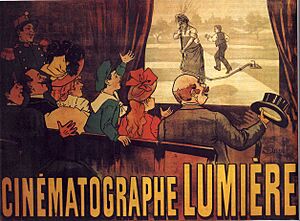
The movie industry began in Paris. Auguste and Louis Lumière showed the first motion picture to a paying audience on December 28, 1895. Many concert halls in Paris became cinemas in the 1930s. Paris's largest cinema room is in the Grand Rex theatre, with 2,700 seats. Large multiplex cinemas have been built since the 1990s.
Parisians enjoy movies like people in other big cities. Hollywood films are very popular. French cinema is also very popular, with directors like Claude Lelouch and Luc Besson. European and Asian films are also widely shown.
Restaurants and Food
Since the late 1700s, Paris has been known for its restaurants and haute cuisine. This means food that is carefully prepared and beautifully presented. The first luxury restaurant, La Taverne Anglaise, opened in 1786. Famous 19th-century Paris restaurants were often near theaters. Several well-known restaurants today, like Maxim's and the Tour d'Argent, appeared during the Belle Époque.
Today, Paris has over 9,000 restaurants. You can find almost every type of French and international food. The Michelin Guide has been a guide to French restaurants since 1900. It gives three stars to the best restaurants. In 2018, ten of France's 27 Michelin three-star restaurants were in Paris. These include places serving classic French food and those mixing French and Asian styles. Many famous French chefs have three-star restaurants in Paris.
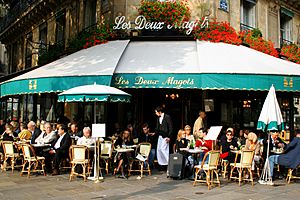
Paris has other traditional eating places. The café arrived in Paris in the 1600s. By the 1700s, Parisian cafés were centers of city life. The Café Procope on the Left Bank is from this time. In the 1900s, Left Bank cafés like Café de Flore were important meeting spots for artists and writers.
A bistro is a small, local restaurant with simple decor and prices. Real bistros are becoming rarer in Paris. A brasserie was originally a tavern next to a brewery. Now, like cafés, brasseries serve food and drinks all day.
Fashion in Paris

Since the 1800s, Paris has been an international fashion capital. It is especially known for haute couture (custom-made clothing). It is home to some of the world's largest fashion houses, like Dior and Chanel. Many other famous designers, such as Karl Lagerfeld and Jean-Paul Gaultier, are also based here. Paris Fashion Week, held in January and July, is one of the top four fashion events in the world. Paris is also home to the world's largest cosmetics company, L'Oréal. Three of the top five global luxury fashion accessory makers, Louis Vuitton, Hermés, and Cartier, are also in Paris. Most major fashion designers have showrooms along the Avenue Montaigne.
Photography in Paris
The first permanent photograph was made in Paris in 1825 by Nicéphore Niépce. In 1839, Louis Daguerre patented the Daguerrotype, a popular early form of photography. The work of Étienne-Jules Marey in the 1880s helped develop modern photography. Photography became important in Parisian Surrealist art. Many photographers became famous for their pictures of Paris. These include Eugène Atget, known for street scenes, and Robert Doisneau, famous for playful pictures of people. Poster art also became an important art form in Paris in the late 1800s.
Media in Paris
Paris and its nearby suburbs are home to many newspapers and magazines. These include Le Monde, Le Figaro, and Libération. France's two most respected newspapers, Le Monde and Le Figaro, are central to the Parisian publishing industry. Agence France-Presse, one of the world's oldest news agencies, is based in Paris. France 24, a government-owned news channel, is also in Paris.
The most-watched TV network in France, TF1, is in nearby Boulogne-Billancourt. Other TV stations like France 2 and Canal+ are also in or around the capital. Radio France, France's public radio broadcaster, has its main office in Paris. Radio France Internationale, another public broadcaster, is also based in the city. Paris also hosts the main office of La Poste, France's national postal service.
Holidays and Festivals
Bastille Day is Paris's biggest festival. It celebrates the storming of the Bastille in 1789. A military parade takes place every year on July 14 on the Champs-Élysées. It includes a flypast by the Patrouille de France and fireworks at the Eiffel Tower.
Other yearly festivals include Paris-Plages, where the Seine's Right Bank becomes a temporary beach in summer. There are also Journées du Patrimoine, Fête de la Musique, and Nuit Blanche. The Carnaval de Paris is one of Paris's oldest festivals.
Libraries in Paris
The Bibliothèque nationale de France (BnF) runs public libraries in Paris. These include the François Mitterrand Library and the Richelieu Library. The Bibliothèque Forney focuses on decorative arts. The Bibliothèque historique de la ville de Paris holds historical research about Paris. The Sainte-Geneviève Library, built in the mid-1800s, has rare books. The Médiathèque Musicale Mahler has music collections. The François Mitterrand Library, with its four glass towers, was finished in 1994.
Paris also has many university libraries. The Sorbonne Library is the largest university library in Paris.
Sports in Paris
Paris's most popular sports clubs are the association football club Paris Saint-Germain F.C. and the rugby union clubs Stade Français and Racing 92. The 80,000-seat Stade de France is just north of Paris. It was built for the 1998 FIFA World Cup. It is used for football, rugby, and athletics. It hosts the France national football team and the France national rugby union team.
Paris hosted the Olympic Games in 1900, 1924, and 2024. The city also tried to host the 1992, 2008, and 2012 Olympic Games.
Paris hosted the finals of the 1938 and 1998 FIFA World Cups. It also hosted the 2007 and 2023 Rugby World Cups at the Stade de France. Paris also hosted the finals of the 1960, 1984, and 2016 UEFA European Championships.

The final stage of the Tour de France bicycle race always finishes in Paris. Since 1975, it has ended on the Champs-Élysées. Tennis is also popular. The French Open, held every year at Roland Garros, is one of the four major Grand Slam tennis events. The 17,000-seat Bercy Arena hosts the annual Paris Masters tennis tournament.
Basketball teams Levallois SCB and Paris Basket Racing merged in 2007 to form Metropolitans 92. In 2018, Paris Basketball was founded and quickly became successful, winning the 2023–24 EuroCup.
The professional handball club Paris Saint-Germain Handball plays in France's top league. In 2023, the Paris Musketeers, an American football team, joined the European League of Football.
Paris Infrastructure
Transportation in Paris
Paris is a major hub for trains, roads, and air travel. The Île-de-France Mobilités (IDFM) manages the region's public transport. The RATP operates 347 bus lines, the Métro, and eight tramway lines. The SNCF runs suburban trains and other tram lines.
Paris has one of the most sustainable transportation systems in the world. It won the Sustainable Transport Award in 2008 and 2023. In 2022–2023, 53.3% of trips in Paris were on foot. 30% were by public transport, 11.2% by bicycle, and 4.3% by car. Bike lanes are being increased, and electric car incentives are being offered. Paris is also banning the most polluting cars from key areas.
Walking in Paris
Walking is the most popular way to get around Paris. It accounts for 53% of all trips in 2024. The number of trips made on foot increased by 50% from 2000 to 2018. Paris is considered a very walkable city.
Railways in Paris
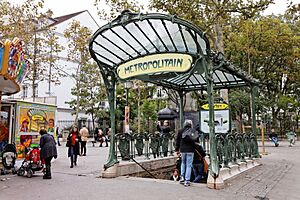
Paris is a central point for France's rail network. Its six main railway stations connect to high-speed trains (TGV, Eurostar), normal speed trains, and suburban trains (Transilien). The Transilien network has 9 lines and 392 stations.
The Paris Métro opened its first line in 1900. It is now the city's most used local transport system. In 2015, it carried about 5.23 million passengers daily. It has 16 lines and 321 stations. The RER is a regional express network. Its five lines connect Paris to further parts of the urban area. The RER A is Europe's busiest metro line. The Paris region also has a light rail network with 15 lines.
Air Travel in Paris
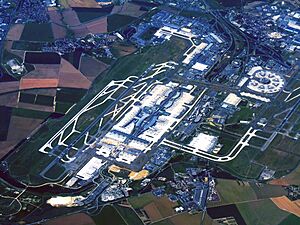
Paris is a major international air transport hub. It is the 5th busiest airport system in the world. Paris has three commercial international airports: Charles de Gaulle Airport, Orly Airport, and Beauvais–Tillé Airport. In 2019, these airports handled 112 million passengers. Paris–Le Bourget Airport is used for private flights and air shows. Charles de Gaulle Airport opened in 1974. In 2023, it was the 4th busiest airport in the world for international travel. It is the main hub for Air France.
Motorways in Paris
Paris is the most important hub of France's motorway network. It is surrounded by three ring roads: the Périphérique, the A86 in the inner suburbs, and the Francilienne in the outer suburbs. Paris has a large road network with over 2,000 kilometers of highways.
Waterways in Paris
The Paris region is France's busiest area for water transport. Most cargo is handled by the Ports of Paris. Rivers like the Loire and Rhine can be reached by canals connected to the Seine. These include the Canal Saint-Martin.
Cycling in Paris
Paris has 440 kilometers of cycle paths and routes. These include bike lanes separated from traffic and painted bike lanes. Some bus lanes can also be used by cyclists. Cyclists can ride in both directions on certain one-way streets. Paris has a bike sharing system called Vélib'. It has over 20,000 public bicycles at 1,800 stations.
Electricity in Paris
Electricity is supplied to Paris through a network fed by various sources. In 2012, about 50% of electricity in the Île-de-France came from cogeneration plants. Other sources included thermal power and waste burning. A quarter of the city's heating will come from a plant burning coal and wood pellets.
Water and Sanitation in Paris
In its early history, Paris only had the Seine and Bièvre rivers for water. From 1809, the Canal de l'Ourcq brought cleaner water from the northeast. From 1857, Eugène Belgrand built new aqueducts. These brought water from around the city to reservoirs.
This new system became Paris's main source of drinking water. The old system's water was then used to clean Paris's streets. This system is still a major part of Paris's water supply. Today, Paris has over 2,400 kilometers of underground sewers.
Air pollution in Paris, especially from small particles (PM10), is the highest in France. Paris also has one of the highest levels of nitrogen dioxide pollution in the EU.
Parks and Gardens in Paris
Paris has over 421 city parks and gardens. They cover more than 3,000 hectares and have over 250,000 trees. Two of Paris's oldest and most famous gardens are the Tuileries Garden (created in 1564) and the Luxembourg Garden (created in 1612). The Jardin des plantes was Paris's first botanical garden, started in 1626.
Between 1853 and 1870, Napoleon III and Jean-Charles Adolphe Alphand created the Bois de Boulogne, Bois de Vincennes, Parc Montsouris, and Parc des Buttes-Chaumont. These parks are located around Paris. They also created many smaller parks and gardens. Since 1977, the city has added 166 new parks. These include the Parc de la Villette (1987) and Parc André Citroën (1992). One of the newest parks is the Promenade des Berges de la Seine (2013), which has floating gardens.
Cemeteries in Paris
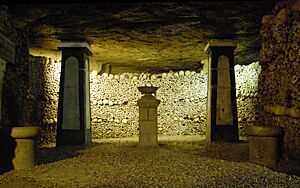
In Roman times, Paris's main cemetery was outside the city. Later, churches had burial grounds. As Paris grew, these became too full. In 1786, burials inside the city were stopped. The remains from old cemeteries were moved to renovated stone mines, now the Catacombs of Paris.
Later, three large cemeteries were created outside the city limits. These were Père Lachaise, Montmartre, and Montparnasse. New suburban cemeteries were added in the early 1900s. Famous people buried in Parisian cemeteries include Oscar Wilde, Frédéric Chopin, and Jim Morrison.
Education in Paris
Paris has the highest number of highly educated people in France. In 2009, about 40% of Parisians had a university degree or higher. Only 13% had no diploma. Education in Paris and the Île-de-France region employs about 330,000 people. This includes 170,000 teachers and professors. They teach about 2.9 million students.
The University of Paris, founded in the 1100s, is often called the Sorbonne. In 1970, it was divided into 13 separate universities after student protests. Most campuses are still in the Latin Quarter, where the old university was.
The Paris region has France's highest number of grandes écoles. These are special higher-education centers. Most of these schools moved to the suburbs in the 1960s and 1970s. The École Normale Supérieure remains in the 5th arrondissement.
In 2025, Paris is home to famous universities in science and technology, political science, and business.
Healthcare in Paris
Healthcare and emergency medical services in Paris are provided by the Assistance publique – Hôpitaux de Paris (AP-HP). This is a public hospital system with over 90,000 employees in 44 hospitals. It is the largest hospital system in Europe. The hospitals have over 5.8 million patient visits each year.
One of the most notable hospitals is the Hôtel-Dieu. It was founded in 651 and is the oldest hospital in Paris still operating. Other hospitals include Pitié-Salpêtrière Hospital, one of Europe's largest, and Necker–Enfants Malades Hospital.
Paris International Relations
International Organizations
The United Nations Educational, Scientific and Cultural Organization (UNESCO) has been based in Paris since 1958. Paris also hosts the main office of the Organisation for Economic Co-operation and Development (OECD). Other international groups in Paris include the European Space Agency and the International Energy Agency.
Sister Cities
Since April 1956, Paris has been exclusively twinned with:
- Rome, Italy
- Seule Paris est digne de Rome; seule Rome est digne de Paris.
- Only Paris is worthy of Rome; only Rome is worthy of Paris.
Other Partnerships
Paris has friendship and cooperation agreements with many other cities around the world.
- Algiers, 2003
- Amman, 1987
- Amsterdam, 2013
- Athens, 2000
- Beijing, 1997
- Beirut, 1992
- Berlin, 1987
- Buenos Aires, 1999
- Cairo, 1985
- Casablanca, 2004
- Chicago, 1996
- Copenhagen, 2005
- Dakar, 2011
- Doha, 2010
- Geneva, 2002
- Istanbul, 2009
- Jakarta, 1995
- Jericho, 2009
- Kyoto, 1958
- Lisbon, 1998
- London, 2001
- Madrid, 2000
- Mexico City, 1999
- Montevideo, 2013
- Montreal, 2006
- Moscow, 1992
- Phnom Penh, 2007
- Porto Alegre, 2001
- Prague, 1997
- Quebec City, 1996
- Rabat, 2004
- Ramallah, 2011
- Rio de Janeiro, 2009
- Riyadh, 1997
- Saint Petersburg, 1997
- Sanaa, 1987
- San Francisco, 1996
- Santiago, 1997
- São Paulo, 2004
- Seoul, 1991
- Sofia, 1998
- Sydney, 1998
- Tbilisi, 1997
- Tel Aviv, 2010
- Tokyo, 1982
- Tunis, 2004
- Warsaw, 1999
- Washington, D.C., 2000
- Yerevan, 1998
Images for kids
-
The Palais de la Cité and Sainte-Chapelle, seen from the Left Bank in 1410.
-
The Bastille prison being stormed on July 14, 1789.
-
The Panthéon, a major landmark on the Left Bank, finished in 1790.
-
The Eiffel Tower being built in November 1888. It was a very modern structure for its time.
-
General Charles de Gaulle celebrating the liberation of Paris on the Champs-Élysées, August 26, 1944.
-
The Élysée Palace, the official home of the President of France.
-
The Front de Seine area along the Seine river.
-
Sacré-Cœur church in Montmartre.
-
La Défense, Europe's largest business district, west of Paris.
-
Axa's main office at Hôtel de La Vaupalière.
-
The main office of Crédit Agricole in Montrouge, south of Paris.
-
The Louvre, the most visited art museum in the world.
-
Magdalena Frackowiak at Paris Fashion Week in Autumn 2011.
-
Auguste Renoir, Bal du moulin de la Galette, 1876, oil on canvas, 131 x 175 cm, Musée d'Orsay.
-
The Comédie Française (Salle Richelieu).
-
The Les Deux Magots café on Boulevard Saint-Germain.
-
Poster for the Lumière brothers' 1895 film L'Arroseur Arrosé, the first comedy and fictional story film.
-
The Moulin Rouge has hosted many singers, including Parisian Édith Piaf.
-
The 2010 Tour de France finishing on the Champs Élysées.
-
The Paris Métro is the busiest subway network in the European Union.
-
In 2023, Charles de Gaulle Airport was Europe's third-busiest airport and the world's eleventh-busiest.
-
The Paris Catacombs hold the remains of about 6 million people.
See also
 In Spanish: París para niños
In Spanish: París para niños








